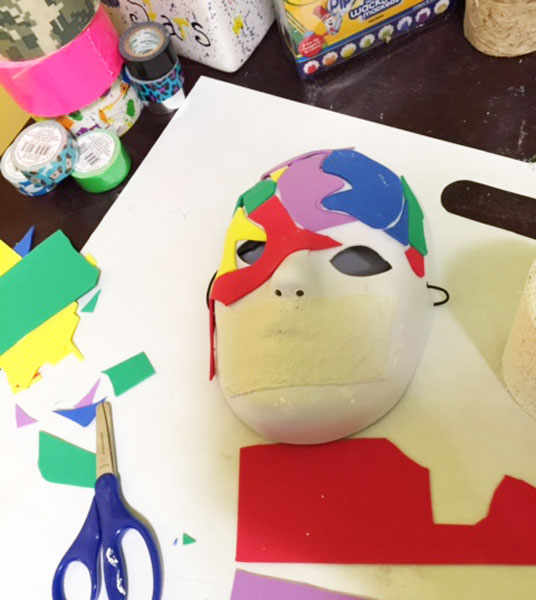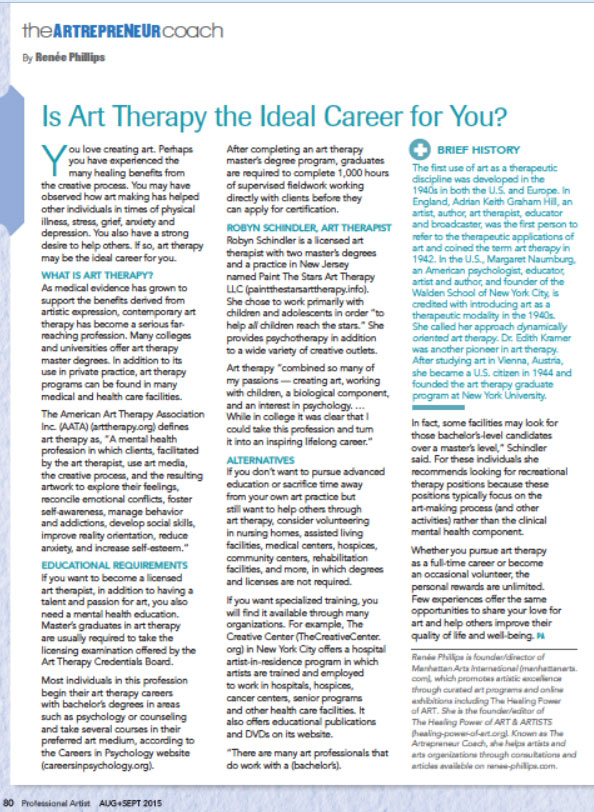
The first use of art as a therapeutic discipline was developed in the 1940′s in both the U.S. and Europe. During World War I, Red Cross volunteers and occupational therapists worked with soldiers to treat PTSD. In England, Adrian Keith Graham Hill, an artist, author, art therapist, educator and broadcaster, was the first person to refer to the therapeutic applications of art and coined the term “Art Therapy” in 1942. While being treated in a sanatorium for tuberculosis, Hill suggested art projects to his fellow patients and observed the healing benefits. In 1945 he published his work as an art therapist in a book titled Art Versus Illness.
In the U.S. Margaret Naumburg, an American psychologist, educator, artist and author, and founder of the Walden School of New York City is credited with introducing art as a therapeutic modality in the 1940s. She called her approach Dynamically Oriented Art Therapy. Dr. Edith Kramer was another pioneer in Art Therapy. After studying art in Vienna, Austria she became a U.S. citizen in 1944 and founded the Art Therapy graduate program at New York University.
During World War II, the practice caught on at Walter Reed Hospital. In the 1960s, the first formal training program for art therapists was founded at Drexel’s Hahnemann University Hospital. Today, contemporary Art Therapy is a serious multi-faceted profession and many colleges and universities offer Art Therapy master degrees.
What exactly is Art Therapy?
For everything there is to know about Art Therapy there is one definitive source — American Art Therapy Association, Inc., an organization of professionals “dedicated to the belief that making art is healing and life enhancing.” AATA provides standards of professional competence, and develops and promotes knowledge in, and of, the field of art therapy.
On the AATA website you’ll find wealth of information including, “Art Therapy is a mental health profession in which clients, facilitated by the Art Therapist, use art media, the creative process, and the resulting artwork to explore their feelings, reconcile emotional conflicts, foster self-awareness, manage behavior and addictions, develop social skills, improve reality orientation, reduce anxiety, and increase self-esteem.”
What does an Art Therapist actually do?
To answer this question I turned to Robyn Schindler, an Art Therapist with her own practice Paint The Stars Art Therapy, LLC (PTSAT), in New Jersey, which she created in order “to help all children reach the stars!” PTSAT offers a wide variety of creative outlets to be used alongside psychotherapy.
Robyn Schindler helps children, teens and young adults from 3 through 21. The children she sees suffer from a variety of issues including but not limited to: Depression, Anxiety, Anger, Obsessive Compulsive Disorder, Oppositional Defiance Disorder, Bipolar, Family related issues, issues (i.e. divorces, blended families), Behavioral issues (such as acting out in school and/or home, continuous tantrums), Psychotic Disorders, Trauma related issues (i.e. abuse, loss of a parent), Developmental Delays including Autism Spectrum diagnoses, and more.
She states, “I also see some children for preventative reasons when a parent believes a child may be on the cusp of certain issues and is looking to stop it before it starts.”
RP: Robyn, what is your definition of Art Therapy?
RS: “I believe that art is anything that a person creates, be it with paint, words, song, dance, etc. Art has a natural healing component in its own right. The act of creating art can be a source of relaxation, a cathartic release or just a pleasant distraction. Since I work with children I find that most children use the art making process as a way to open up and feel more comfortable speaking about certain things or issues they normally would avoid.”
RP: How does Art Therapy help young people express themselves?
RS: “Children, as a specific population, communicate through play and creativity. If you watch a child play they are slowly creating their own world. Some create a place of escape while others create a place of familiarity. This starts as early as being in a crib with basic toys and continues throughout their development. As a therapist specializing in children you want every child to invite you into their world of play and imagination.”
RP: What educational background is required to become an Art Therapist?
RS: “To be a psychotherapist or counselor you need a Masters Degree in a related field such as Psychology, Mental Health Counseling, Marriage and Family Therapy, Addictions, etc. Because I had chosen to specialize in Art Therapy, I decided to pursue my Masters in Mental Health Counseling before going on to Art Therapy because so many states lack a license in Art Therapy. Since the moment I found Art Therapy, I also believed that a strong background in psychology would be important and so I made the individual decision to do two Masters Degrees. I have my MS in Mental Health Counseling as well as an additional Masters (MA) in Clinical Art Therapy.”

RP: What titles and licenses do you hold?
RS:“Licensed Creative Art Therapist (LCAT-this is a NY based license although NJ is presently working on an equivalent), Licensed Professional Counselor (LPC in NJ), Registered and Board Certified Art Therapist (ATR-BC; nationwide) and a National Certified Counselor (NCC). I also have received certificates in Play and Sand-tray therapies.”
To learn more about Art Therapy visit the American Art Therapy Association: arttherapy.org
To learn more about Robyn Schindler and Paint The Stars Art Therapy, LLC visit: paintthestarsarttherapy.info
I wrote an article “Is Art Therapy the Ideal Career for You? for the August-September 2015 issue of Professional Artist magazine.
Art Therapy is a fascinating practice and discipline. I look forward to bringing more articles to you on the subject in the future. Please write your comments and questions below.

Bless you Renee! YOU are at the forefront of promoting Art & Healing! For that we are grateful!
I have in the last few years become a Teaching Artist in tandem with Art Therapists. It is amazing how art can contribute to the healing process that children and adults are involved with. Whether it’s a relief to be involved with an activity that takes one away from the troubles of their lives OR whether break throughs can occur. It is deep, meaningful and powerful. I am humbled by the children and adults, as well as the therapists I have been honored to work with. Tho the affiliations I have, do not usually use mask making as a safe way to delve into issues. It can sometimes be counter productive. Best as always Renee!
Hi France, thank you for stopping by and for your comment. I appreciate your much needed efforts to help others using the therapeutic benefits of art. France, I wish you continued creative bliss! ~ Renee
Lavoro nel sociale, ed è già questo un motivo di orgoglio e di gioia,
La mia passione e l arte della pirografia su lagenarie e vecchi mestieri,
Ciò che vorrei è imparare ed insegnare, dare e avere, mostrare e vedere ,
Costruire strade di comunicazione verbale
Conquistare nuovi sorrisi con arte ,cultura, gioia e fantasia
I enjoyed this discussion of our profession and would like to add a few points.
No mention was made of Margaret Naumburg, who preceded Edith Kramer, and was also a key founder of the Art Therapy program in New York University (where I was lucky enough to have studied under Professor Kramer in the late ’90’s.)
A main component of what Art Therapy does was termed as, “sublimation” by Kramer, who defined it in her book, “Art as Therapy With Children” as a redirecting of our basic drive energies, which may otherwise lead us into destructive activities and feelings, “onto achievement, which is highly valued by the ego, and is, in most instances, socially productive.”.
In my work with adolescents, and other clients with anger issues I work with individuals who have extremely powerful drives that they often don’t know how to keep in check. When I focus on working to help them sublimate their energies through the use of Art Therapy I have seen wonderful results.
Thank you for this website.
Thank you very much Ellis Eisner for sharing this vital information about Margaret Naumburg. I added her to the article. Curious to learn more about you I tried to visit your website http://www.elliseisnerarttherapist.com/ that you posted with your comment but unfortunately I could not gain access – it said “This site has expired”. I will try again another time. I hope you visit the website often. Best regards, Renee
l’arte è una terapia x le malattie. Ho sperimentato io stessa: infatti sono stata operata di tumore ( carcinoma al seno ) e il dipingere è stato x me avere fiducia di nuovo nella vita ( sono trascorsi oltre 20 anni). Da ragazza avevo frequentato corsi all’Accademia di Brera e ripreso poi dopo i 3 interventi subiti .Ho cominciato anche a viaggiare e confrontarmi con vari artisti. . Un caloroso saluto a Lei Renee Philips
zia Francesca Fiumano